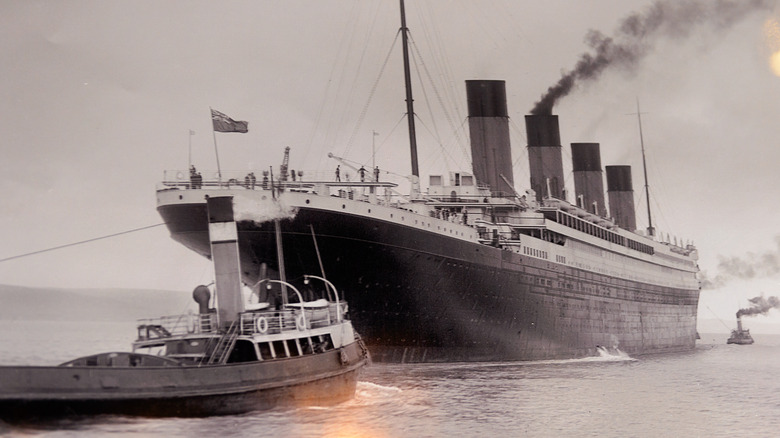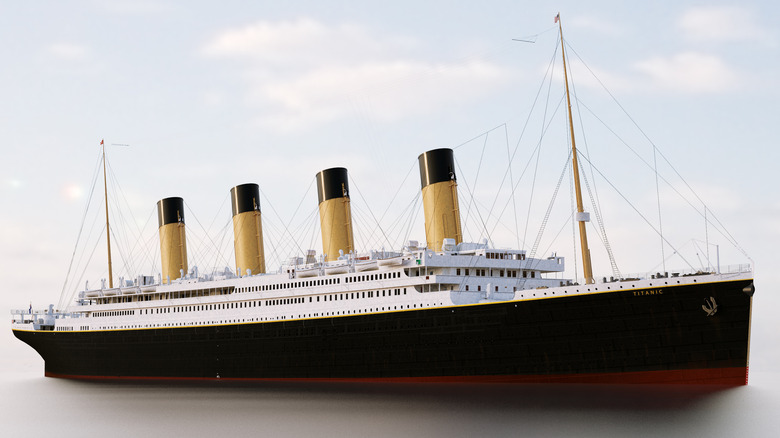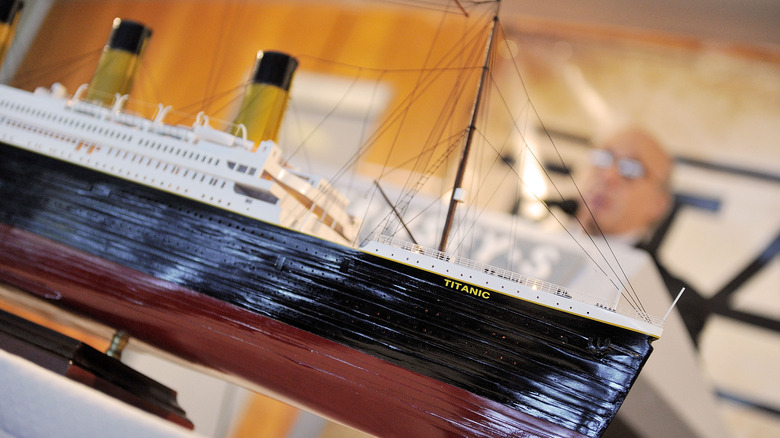Why There Were Four Smokestacks On The Titanic
There will probably never be another ship as infamous, as tragic, and as heart-wrenching as RMS Titanic. The vessel, as Britannica reports, was created at the turn of the 20th century, the very last word in opulence, in order to capitalize on the wealthy patrons' taste at the time for exciting journeys across the Atlantic.
The pride of the White Star Line, Titanic's maiden voyage from Southampton to New York City, in April 1912, was set to be an event to remember. This, sadly, it certainly proved to be, though many, including White Star Line Vice-President Philip Franklin, could never have foreseen the ship's tragic fate. Earlier that same year, Franklin had boldly insisted that it was absolutely impossible for the ship to sink. "The boat is unsinkable and nothing but inconvenience will be suffered by the passengers," Franklin stated, per the BBC.
The horrendous tragedy that was its sinking claimed the lives of more than 1,500 people, the website goes on. For this reason, the Titanic remains perhaps the best-known and most publicized ship in history, though luxury liners and cruise ships have since been constructed that are far, far larger. The iconic quartet of smokestacks may be the feature that's most recognizable.
A coal-ossal amount of fuel was needed
As Britannica reports, RMS Titanic was among the biggest ships in the world at the time of its construction. At 882.5 feet in length and topping out at 52,000 tons, the sheer scope and strength of the vessel was surely a major contributor in the "unsinkable" line of thinking. What harm could possibly come to a ship of such splendor, such size, such awe? Now we know the answer to that, but it's interesting to think that Titanic would be rather modest by the standards of today.
Royal Caribbean's colossal Wonder of the Seas, for instance, is 1,188 feet (362 meters) long and boasts a gross tonnage of 235,600, according to the Royal Caribbean Press Center. Some of the newest ships, in these environmentally-troubled times, utilize revolutionary methods of power to propel their magnificent bodies through the water. Princess reports that their vessel Sun Princess is powered by liquified natural gas, or LNG. According to the company, "this cleaner burning fuel will significantly reduce air emissions and marine gasoil (a type of fuel) to minimize our environmental footprint."
The Titanic, over a century earlier, was powered by coal. Lots and lots of it. Ripley's Believe It Or Not! states that 600 tons of this precious resource were expended by the ship's steam engines and steam turbine every day, every piece of which was shoveled in by a workforce of 176 men. The heat and smoke produced below decks necessitated the huge smokestacks.
Form meets function in the Titanic's smokestacks
Why four smokestacks, though? At the time, this was quite a prestigious arrangement. According to The Great Ocean Liners, Kaiser Wilhelm II attended a showcase of British naval might in 1889, and was delighted by the White Star Line's formidable vessel, Teutonic. He resolved to create a ship even mightier and more lavish, and by May 1897, he succeeded with the Kaiser Wilhelm der Gross. This was the first vessel ever to sport four funnels, a design that, per the outlet, "for the next decade would be the symbol of size and safety."
With this in mind, there was no doubt that Titanic, which itself was designed to be as awe-inspiring as possible, would also have four funnels. They served the obvious, chimney-esque purpose for the boilers powering the ship, but on an aesthetic level, they also looked absolutely majestic. According to BBC Bitesize, only three were required as smokestacks for the boilers, and the fourth was added to complete the "four-stacker" look that was the style of the time. According to Ultimate Titanic, Thomas Andrews, who designed the ship, settled on three funnels, but the White Star Line wanted a full complement. The fourth, then, seems to have provided additional ventilation for the engine rooms, which absolutely wouldn't have gone amiss. Ultimately, there remain many mysteries about the mighty Titanic.


